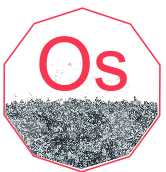Osmium

Osmium (Os)
General Information
- Symbol: Os
- Atomic Number: 76
- Atomic Weight: 190.23 u
- Element Category: Transition metal
- Group: 8
- Period: 6
- Block: d-block
Physical Properties
- Appearance: Bluish-white, lustrous metallic
- Density: 22.59 g/cm³ (highest of all elements)
- Melting Point: 3033 °C (5491 °F)
- Boiling Point: 5012 °C (9054 °F)
- Phase at STP: Solid
- Electron Configuration: [Xe] 4f¹⁴ 5d⁶ 6s²
- Oxidation States: +8, +6, +4, +3, +2, +1, 0, -2
Chemical Properties
- Reactivity: Osmium is generally unreactive but can form oxides when heated. It forms a variety of compounds, especially with halogens and sulfur.
- Compounds: Forms compounds such as osmium tetroxide (OsO₄), osmium dioxide (OsO₂), and osmium chloride (OsCl₄).
Uses and Applications
- Alloys: Used to harden platinum and other alloys, especially for electrical contacts and fountain pen tips due to its hardness and durability.
- Catalysts: Employed as a catalyst in certain chemical reactions, including the Haber process for synthesizing ammonia.
- Osmium Tetroxide: Used in staining biological specimens for microscopy and in fingerprint detection.
- Jewelry and Watches: Sometimes used in high-end jewelry and watchmaking due to its density and durability.
Occurrence and Extraction
- Natural Occurrence: Found in platinum ores and as a trace element in alluvial deposits. Often found in the minerals osmiridium (an alloy of osmium and iridium) and iridosmine.
- Extraction: Extracted as a byproduct of nickel and copper mining. The extraction process involves isolating osmium from other platinum group metals through chemical processes.
Isotopes
- Stable Isotopes: Osmium has seven stable isotopes, including Osmium-184, Osmium-187, Osmium-188, Osmium-189, Osmium-190, and Osmium-192.
- Radioactive Isotopes: Osmium-186 is radioactive but has a very long half-life and is used primarily in scientific research.
Safety and Handling
- Hazards: Osmium itself is not highly toxic, but osmium tetroxide (OsO₄) is highly toxic and volatile. It can cause severe damage to the eyes, skin, and respiratory system.
- Precautions: Handle osmium tetroxide with extreme care, using appropriate protective equipment and working in a well-ventilated area or fume hood.
History
- Discovery: Discovered by Smithson Tennant in 1803.
- Name Origin: Named from the Greek word “osme,” meaning smell, due to the strong odor of its volatile oxide, osmium tetroxide.
Additional Facts
- Crystal Structure: Hexagonal close-packed (hcp)
- Magnetic Properties: Paramagnetic
- Thermal Conductivity: Moderate, about 87.6 W/m·K
- Electrical Resistivity: About 81 nΩ·m at room temperature
Summary
Osmium is a dense, hard, bluish-white transition metal known for its high melting point and resistance to wear. It is used in various high-durability applications, including alloys, catalysts, and certain industrial processes. Found primarily in platinum ores, osmium is extracted as a byproduct of nickel and copper mining. Osmium tetroxide, a volatile and highly toxic compound, requires careful handling.
40 Question and Answer Pairs About Osmium
What is the atomic number of Osmium?
- 76
What is the symbol for Osmium?
- Os
What is the atomic weight of Osmium?
- 190.23 u
In which group of the periodic table is Osmium found?
- Group 8
What period is Osmium in?
- Period 6
What block does Osmium belong to?
- d-block
What is the melting point of Osmium?
- 3033 °C (5491 °F)
What is the boiling point of Osmium?
- 5012 °C (9054 °F)
What is the density of Osmium?
- 22.59 g/cm³
What is the electron configuration of Osmium?
- [Xe] 4f¹⁴ 5d⁶ 6s²
What are the common oxidation states of Osmium?
- +8, +6, +4, +3, +2, +1, 0, -2
What is the appearance of Osmium?
- Bluish-white, lustrous metallic
Is Osmium reactive with air?
- Generally unreactive, but forms oxides when heated.
Name a compound of Osmium.
- Osmium tetroxide (OsO₄)
What is a common use of Osmium in alloys?
- Used to harden platinum and other alloys.
How is Osmium used in catalysis?
- Employed in chemical reactions like the Haber process for synthesizing ammonia.
What role does Osmium tetroxide play in microscopy?
- Used for staining biological specimens.
How is Osmium used in jewelry?
- Used in high-end jewelry and watchmaking.
What application does Osmium have in electrical contacts?
- Used due to its hardness and durability.
Name a mineral that contains Osmium.
- Osmiridium
How is Osmium extracted from ores?
- As a byproduct of nickel and copper mining through chemical processes.
What is the most stable isotope of Osmium?
- Osmium-192
Name a radioactive isotope of Osmium used in research.
- Osmium-186
What safety hazard is associated with Osmium tetroxide?
- It is highly toxic and volatile.
Who discovered Osmium?
- Smithson Tennant
Where does the name Osmium come from?
- From the Greek word “osme,” meaning smell.
What is the crystal structure of Osmium?
- Hexagonal close-packed (hcp)
Is Osmium paramagnetic or diamagnetic?
- Paramagnetic
What is the thermal conductivity of Osmium?
- About 87.6 W/m·K
What is the electrical resistivity of Osmium at room temperature?
- About 81 nΩ·m
What is the primary oxidation state of Osmium?
- +8
Is Osmium found as a free element in nature?
- No, it is found in minerals like osmiridium.
What is the common name of Osmium tetroxide?
- OsO₄
What is a major application of Osmium dioxide (OsO₂)?
- Used in certain industrial catalysts.
How does Osmium benefit electrical contacts?
- Provides hardness and wear resistance.
What is the boiling point of Osmium in Kelvin?
- 5285 K
What group does Osmium belong to in the periodic table?
- Transition metals
What is the natural abundance of Osmium-192?
- About 41%
Can Osmium be used in high-temperature applications?
- Yes, due to its high melting point and stability.
What is the key property that makes Osmium valuable in microscopy?
- Its use in osmium tetroxide for staining biological specimens.






